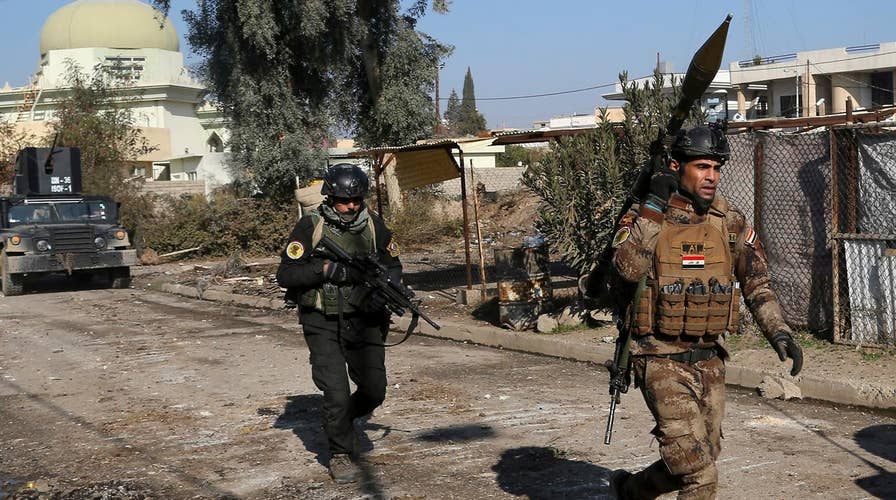In the initial phase of combat to reclaim Mosul, (October 17th through mid-December 2016), the occupying ISIS’ radical Islamic terrorists inflicted heavy casualties (the UN previously estimated approximately 2000 IMC troops killed). Iraqi Military Coalition (IMC) forces cleared only several outlying villages and penetrated just a few blocks inside of eastern Mosul during this period.
ISIS FIGHT STAYS THE COURSE FOR NOW UNDER TRUMP, ARMY GENERAL SAYS
This “slow and bloody slog” prompted Iraqi Prime Minister Abadi to order his IMC generals to temporarily pause combat operations. PM Abadi immediately traveled to the front lines (10 miles south of Mosul) to meet with his generals and assess the IMC operations.
IMC forces were, among other things, confronting ISIS’ use of the following asymmetric tactics to neutralize IMC forces’ superior advantage in firepower:
- Mosul’s trapped civilians as “human shields” to prevent IMC forces from using their tanks and artillery—or suffer heavy civilian casualties;
- Dense smoke from burning tires and entrenched oil fires along the IMC attack axis to obscure the vision and effectiveness of IMC attack helicopters and close air support from bombarding ISIS’ fortifications;
- Extensive underground tunnel system for hiding their movements and stockpiling food, water, ammunition, and sophisticated bomb-making materials/devices;
- Suicide car-bombs launched into the middle of the IMC’s attacking forces;
- Commercial aerial drones adapted with cameras and small bomblets to enhance ISIS’ intelligence collection and bombing against the IMC forces; and
- “Booby-trapped” improvised explosive devices (IEDs) in buildings, embedded in roads, and left under dead bodies.
According to Stephen Kalin of Reuters on January 19, 2017, “The coalition insists that on the battlefield the Iraqis ‘own the plan.’ But Iraqi commanders say the Americans’ advice, like their firepower, has become indispensable.”
HOW ISIS IS TURNING COMMERCIAL DRONES INTO WEAPONS IN THE BATTLE FOR MOSUL
More from OpsLens.com
After 16 days of intense preparations, IMC forces restarted their new “Phase 2” assault on eastern Mosul on December 29, 2016. By January 19, 2017, IMC forces made quick and successful progress in recapturing most of eastern Mosul. This included controlling the approaches to all five US-bombed (and impassable) bridges over the Tigris River that connect western and eastern Mosul.
The latest update (as of January 22, 2017) on the tactical situation in eastern Mosul, according to Joel Wing of “Iraq Musings” (an eight-year-old blogspot covering Iraqi politics, economics, and national security) and the “Falcon Group,” a highly reliable commercial intelligence organization: “The group [ISIS] is facing food shortages in west Mosul, and hunting down deserters, confiscating their property and burning their homes in west Mosul. The group’s defenses collapsed in east Mosul.”
So, let us assess ISIS’ current tactics and operational circumstances. This will enable the IMC to analyze its potential tactical options for the final attack on the ISIS stronghold in western Mosul.
- ISIS’ strong point and operational hub (Mosul University complex) for executing the defense of eastern Mosul has been bombed and recaptured by the IMC forces.
- ISIS has lost 2500 of its 8000 terrorist fighters thus far in the battle for Mosul. This degrades ISIS’ capacity to mass fighters on multiple fronts inside Mosul that can counterattack eventual IMC assault forces.
- The IMC’s bombing of all five bridges crossing the Tigris River that bisects Mosul from north to south, has succeeded in isolating ISIS in western Mosul. IMC forces have surrounded the Mosul metropolitan area. ISIS’ food, supplies, and arms are dwindling.
- ISIS has demonstrated its critical weakness against night fighting. The IMC’s CTS forces, with strong leadership from US special operations forces (SOF), conducted its first successful night operation last week in its penetration to the eastern bank of the Tigris River.
- Now, the IMC is shooting down ISIS’ unmanned aerial drones with classified technical assistance from US forces. This degrades ISIS’ intelligence collection and situational understanding.
- The IMC’s new, more aggressive (mostly US artillery) fire support is bombarding key ISIS operational nodes while keeping civilian casualties relatively low. This firepower has enabled the IMC ground forces to recapture significant operational territory in eastern Mosul.
After studying the operational factors above, I believe that ISIS in western Mosul has several exploitable weaknesses for IMC to consider in its upcoming final attack plans for western Mosul:
- ISIS is surrounded by the IMC and cut off from its supply lines. Time is not on ISIS’ side. IMC forces can, therefore, pick when and where to attack ISIS in western Mosul. The IMC can use some time to make sure they are planning every detail and rehearsing before the attack.
- ISIS’ supreme headquarters in Raqqa has its own survival problems; therefore, ISIS Mosul fighters are not likely to be reinforced or resupplied. Every day makes them weaker.
- The remaining 5000 (+/-) ISIS fighters in western Mosul are too small to react to multiple IMC attacks simultaneously. This weakness could be intensified by IMC feints, ruses, and deception activities. Five thousand ISIS fighters can’t control over 500,000 Mosul civilians who will flee their entrapment. Fleeing civilians can provide actionable intelligence for the IMC.
- ISIS’ cell phone communications can be jammed by the IMC at a time and place of the IMC’s choosing. This can severely degrade ISIS’ command and control.
- ISIS is vulnerable to night attacks now that IMC SOF has become more proficient at night attacks in eastern Mosul. This advantage will enable IMC forces to reduce both military and civilian casualties.
Michael Furlong is a Senior OpsLens Contributor. Furlong is a career Army Infantry Officer, Battalion Task Force Commander, Combat Veteran, and retired Defense Intelligence Senior Executive Service.





















